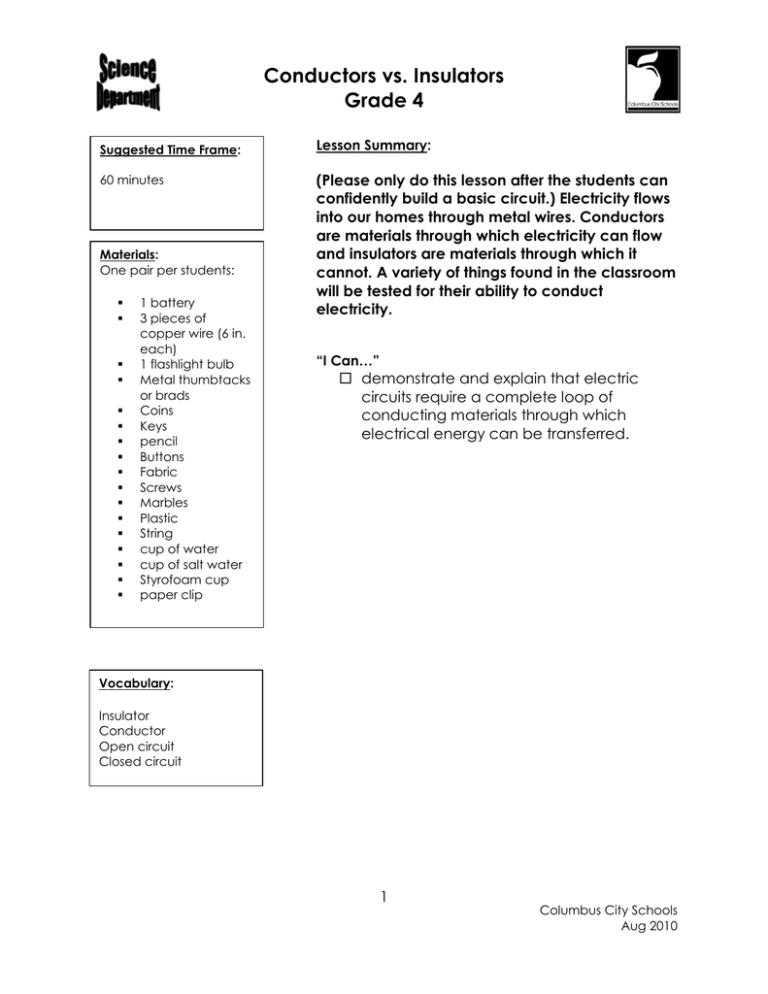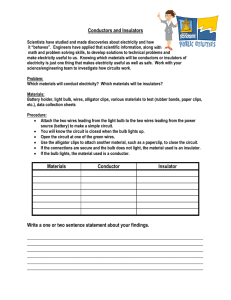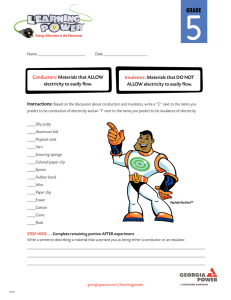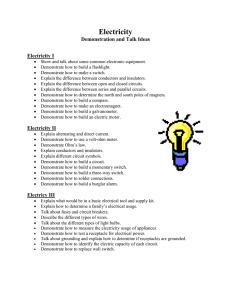Conductors vs. Insulators Grade 4
advertisement

Conductors vs. Insulators Grade 4 Suggested Time Frame: Lesson Summary: 60 minutes (Please only do this lesson after the students can confidently build a basic circuit.) Electricity flows into our homes through metal wires. Conductors are materials through which electricity can flow and insulators are materials through which it cannot. A variety of things found in the classroom will be tested for their ability to conduct electricity. Materials: One pair per students: 1 battery 3 pieces of copper wire (6 in. each) 1 flashlight bulb Metal thumbtacks or brads Coins Keys pencil Buttons Fabric Screws Marbles Plastic String cup of water cup of salt water Styrofoam cup paper clip “I Can…” demonstrate and explain that electric circuits require a complete loop of conducting materials through which electrical energy can be transferred. Vocabulary: Insulator Conductor Open circuit Closed circuit 1 Columbus City Schools Aug 2010 Conductors vs. Insulators Grade 4 Teacher Background Conductors allow electricity flow through them. Conductors are materials that can carry electricity - they conduct electricity. Metal materials such as copper, iron, steel and aluminium are all good conductors of electricity. Insulators do not allow electricity to flow through them. Materials such as wood, plastic, rubber and glass do not carry electricity and are called insulators – they don’t conduct electricity. Insulators and conductors both have important uses in current electricity. Engage (Warm-up) Have each pair of students collect the items that are to be tested. Build a circuit for students to see. Have students consider the circuit. Ask, “How is the light bulb able to receive power from the battery? How does the energy move from the battery to the light bulb?” The energy moves through the metal wire, because metal is a good conductor of electricity. Discuss the terms conductor and insulator so students understand that conductors carry electricity from one point to another and insulators stop the flow of electricity. Have students brainstorm ideas of how the circuit could be used to test materials for their conductivity. Select one conductor and one insulator from the classroom samples (such as a paper clip and a Styrofoam cup.) Following procedures show how the circuit can be used to test for conductivity. Demonstrate what happens to the light bulb when both the conductor and insulator become a part of the circuit. Hand out the worksheet (included below). Allow time for the students to list each item that they are going test and predict if the item will be a insulator or conductor. Explore and Explain (Instructional Strategies) 1. Build and test a circuit. Working in pairs, allow the students time to connect the light bulb to one of the wires and attach the wire to the battery. Connect the other wire to the other side of the battery and then to the light bulb. Be sure the light bulb lights up. 2. Disconnect one of the copper wires from the battery place one of the items to be tested at the end of that wire. Take the third copper wire and connect it from the item being tested to the battery. If the circuit is closed; the item is conducting electricity (a conductor), the bulb will light. If the circuit is open; the item is insulated from passing the electricity (an insulator), the bulb will not light. You will need to watch the students and encourage them to keep firm connections between the bulb, batteries, and testing objects. 3. Test various materials for their conducting ability. Conductors, such as coins, should make the light bulb light. Insulators will not because they do not complete the circuit. 2 Columbus City Schools Aug 2010 Conductors vs. Insulators Grade 4 Extension/Expansion/Elaboration/Interdisciplinary Connections Write a letter from the point of view as a conductor or insulator (e.g. “A day in the life of a conductor”) Essential Questions Students build a complete circuit to light a bulb. After building the circuit, the students close the switch, but the bulb does not light. Describe two possible reasons the bulb does not work in the circuit. Reteach Ideas Add 3 more conductors and 3 more insulators to your chart. Test them if possible. Evaluation/Closure (Lesson Assessment) You have been asked to design a pair of gloves for an electrician. The gloves must protect the electrician from getting shocked by current electricity. What materials would you use? Why would you use these materials? What problems might come from wearing gloves from this material? Extensions/Additional Resources Technology: UnitedStreaming: Hot Line: All About Electricity (15:00) A First Look: Electricity (20:00) Website: http://www.bbc.co.uk/schools/ks2bitesize/science/physical_processes/circuits_cond uctors/play.shtml Fill in the circuit with different items to find the conductors. http://www.culverco.com/sse/wires/game.html Categorize objects into conductors or insulators as you test them in a circuit you build yourself at this site. 3 Columbus City Schools Aug 2010 Conductors vs. Insulators Grade 4 Conductors vs. Insulators Item Prediction Conductor or Insulator 4 Actual Conductor or Insulator Columbus City Schools Aug 2010





